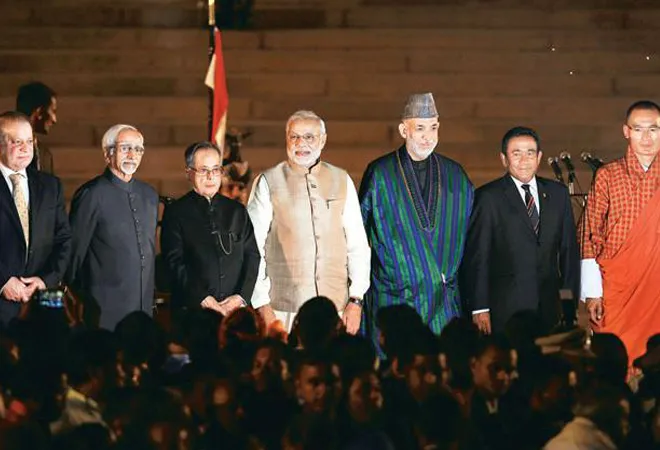
Around the turn of the century, an Indian Parliamentary committee released a rather pessimistic report on the state of India’s trade with its neighbours. Even a brief glance through the report would reveal the small minded and antiquated mercantilist approach of Indian officialdom when it comes to regional trade. For instance, almost three years after signing a free trade agreement with Sri Lanka, very little progress was visible. The reason? Stiff resistance from agricultural lobbies in India who feared that competition from Sri Lanka would drive them out of business. In the case of Bangladesh, India's largest trading partner in the region, the story was the same. India would not concede to Bangladesh’s demands for greater market access for goods like Hilsa fish and Jamdani sarees. It was only when these countries began to talk trade with Pakistan did India pay some attention to these relationships.
Sitting in New Delhi nearly two decades later, it is hard to argue that this report has produced any new wisdom in India. The fact remains that India has failed to serve as an engine of economic prosperity for the entire subcontinent. South Asia remains one of the least integrated subregions in the world. Without benefiting from India’s markets or investments, its neighbours see India as an unattractive and increasingly unwelcome partner. And unlike two decades ago, a more ambitious power is willing to fill the void left by India: Beijing. Unsurprisingly then, India has been pushed to second place by the Chinese who are now the largest trading partners and investors in most of the region.
Even as India now attempts to renegotiate the terms of its engagement, it is clear that emerging geoeconomic and geopolitical realities are altering the course of the region.
For most of the last 70 years, the very idea of South Asia was premised on India as the agent of coherence. Its influence was not just religious, cultural and civilizational, but was also central to the political thought and economic models of South Asia.
This is no longer true today. While South Asia continues to exist as a geographical entity, its economic and political centre of gravity has inexorably shifted away from New Delhi. As a result, the old construct of South Asia is dying, if it is not dead already. And apart from India’s ineffectual statecraft in the region, two key trends have engendered this process.
First, the appeal of liberalism has considerably diminished in South Asia. Most liberal parties in the region have been reduced to the fringe because of the death or disappearance of the centre. Political parties have either moved to the extreme left or the extreme right. While the trappings of democratic governance are visible in the region, the march of illiberalism has seen most countries move away from the Grundnorm predicated on liberal democracy—whether it is jihadism and Islamism in Pakistan, single party domination in Bangladesh, an enervated democracy in Maldives (notwithstanding the results of its recent elections), or ultranationalism in Nepal. To a great extent, this Grundnorm conformed to a Nehruvian vision for the region — and India has long anchored the region’s democratic potential. That vision is now not just being challenged in India but also in its neighbourhood.
Second, China’s ambitions are eroding the very identity of South Asia. Through the Belt and Road Initiative, China is steadily erasing Asia’s colonial legacies — the arbitrary political boundaries that separate its communities. In China’s design, South Asia is but one node in a complex network of infrastructure projects which will ultimately create a Pan Eurasian system. The Middle Kingdom intends to emerge as the sole arbiter of security, development and economic growth in this supercontinent. China cannot afford to let regionalism distract from this objective — nor can it allow powers like India to carve out their own spheres of influence. For China, then, a distinct South Asian identity is purposeless. Instead, a handful of client states like Pakistan and Maldives, and a system of economic patronage with countries like Bangladesh, Nepal and Sri Lanka serve the security and economic interests of its continental ambition. The fact is that there is no space for an independent South Asian construct in China’s mental map of the world.
Since South Asia 1.0 is heading for redundancy after 70 odd years, India must work towards a South Asia 2.0 which ultimately replaces the beta version currently dominated by China.
Complaining or cribbing about China is not going to be of much help. But will competing or confronting China serve any purpose? The power differential between India and China in the economic, technological and military spheres is just too great today and for the near term.
The strategic question, then, is: How should India regain its prominence and influence in the region?
First and foremost, India needs to display strategic patience. In other words, India needs to learn from the Chinese playbook and follow Deng Xiaoping’s dictum of ‘bide your time, hide your capabilities’.
Given existing power equations, it will be impossible for India to play a sufficiently expansive role until it doubles the size of its economy from the current $2.6 trillion to over $5 trillion over the next decade. Trying to exercise influence without the necessary economic heft will only complicate relations with neighbours. It would therefore be a better idea for India to step back for now. Instead of announcing new plans for the region at this point in time, India should meet existing commitments and bide its time until the organic rise of Indian capabilities naturally enhances its role and influence in the neighbourhood.
Second, India must follow the Nehruvian dictum of non intervention in the affairs of other countries. Preaching without power and influence only invites disdain and increases the distance between neighbours.
While India must not compromise on its commitment to a rights based agenda, it must abjure the temptation to make this agenda an extension of the Anglo Saxon version of morality (or if you will, hypocrisy).
Third, India should collaborate, catalyse and become the conduit for Chinese investments across South Asia. While this may appear counterintuitive if the aim is to restore India’s preeminence in the region, it makes great strategic sense. Most of China’s investments will also create infrastructure and regulatory ecosystems that will ease integration of these economies with India’s own market. Over the next decade, when India’s economy exceeds the $5 trillion mark, these very investments will allow Indian money to reclaim influence in the region. This will work if a portion of Chinese money is also routed through Indian instruments — for example, by setting up a South Asian Development Bank (SADB) along the lines of the Asian Infrastructure Investment Bank. Only in this case, the institutional arrangement will support India’s leadership role while China will be the largest partner. The SADB idea can eventually be expanded by setting up an Indian Ocean Development Bank, which will address the development requirements of the Indian Ocean littorals.
It is time for India to step aside and let the neighbours reach their own conclusions on China.
Finally, India will need to balance its relations with the US and China. Paradoxically, both the US and China are critical partners for India to win the battle for South Asia. China’s investments in India’s markets will remain critical to Delhi’s long term economic growth; while the United States’ military capability will help India balance and manage China’s rise. On the one hand, New Delhi will have to embrace Washington as a security partner without limiting its own agency in South Asia. The US is not a very sellable brand today, and bringing the US into India's grand strategy for South Asia may be counterproductive. On the other hand, India must accept Chinese money without acquiescing to its regional design. Indeed, India will have to ride on China’s shoulders if it is to compete with Beijing. This decision would have the best possible precedent: India must leverage Chinese ambition in much the same manner that China’s rise was supported by America’s economy. Finding this balance must be India’s priority in the coming decade.
The reality is that, despite its profound, sincere and emotional commitment to the anti-colonial impulse, New Delhi lazily assumed the focal points of geopolitics will remain the same for decades to come.
Nowhere in the world is this true and cities like Cairo and Baghdad are mere shadows of their former selves. Incubating South Asia 2.0 will require India to stop looking at the region from the imperial prism of the British Raj. New realities and not old shibboleths must guide India’s grand policy in the region. The institutional weaknesses that India inherited at the cusp of independence will need to be fixed for India to be able to blend the sophistication of its modern economy with a 5000 year old civilisational ethos. Rapid economic growth combined with a commitment to liberal democracy within and sustained efforts at regional integration must guide India’s approach. As it grows, India must take the region with her. This is easier said than done, given that some economic commitments to the region may be painful in the short run to India’s own businesses. Those measures require a large heart, bold conviction and far-sighted stewardship, which can only be the product of a forged non-partisan, political consensus.
The views expressed above belong to the author(s). ORF research and analyses now available on Telegram! Click here to access our curated content — blogs, longforms and interviews.




 PREV
PREV



